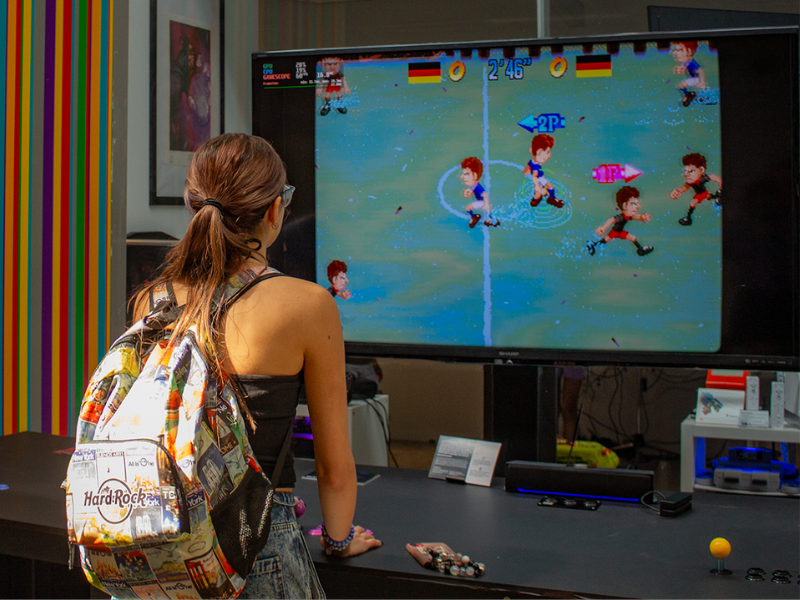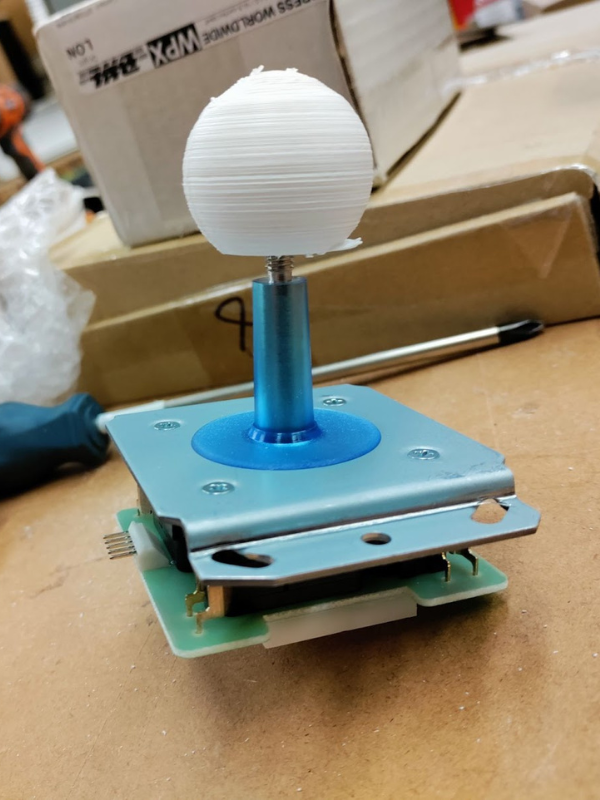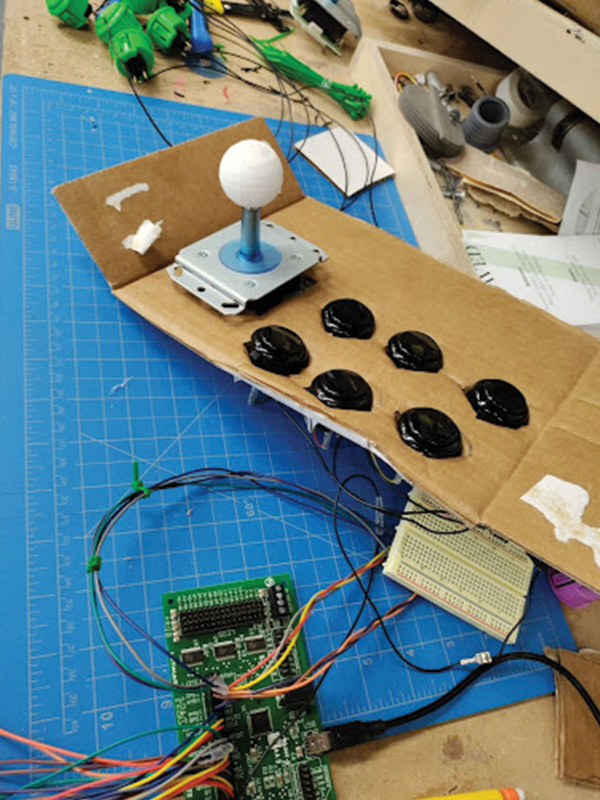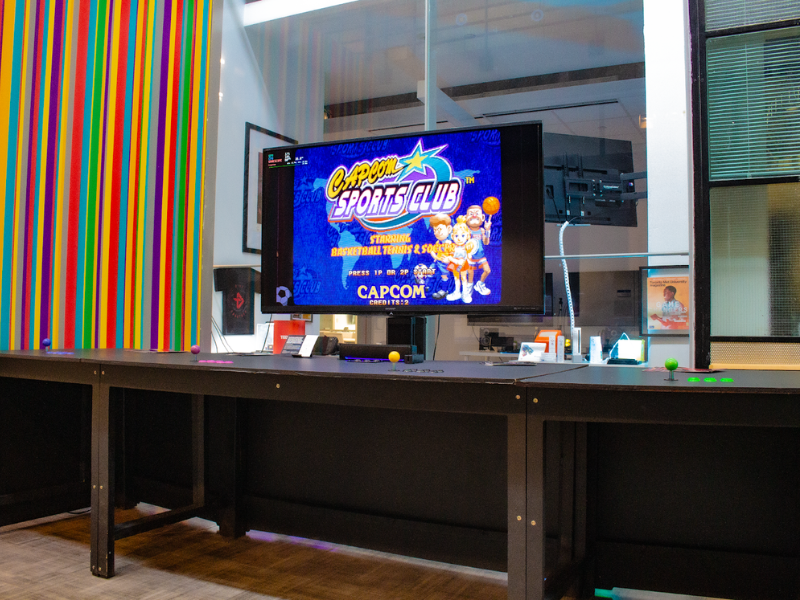New Media and Computer Science students co-create 11-foot community arcade table
With advancements in gameplay, graphics and design, video games have erupted into a multi-billion dollar industry, with its meteoric rise to the top characterized by one discerning feature: community. From the earliest gaming innovations to the cutting-edge events held at The Creative School’s Red Bull Gaming Hub, the evolution of video games has been hastened by generations of passionate community members.
RTA New Media student Angelina Almanza is the fabrication lead of the community arcade table, or CAT6, which provides a physical space where students can gather and play video games developed by their peers, fostering collaboration, creativity, and, most importantly, community engagement. Alongside her peer from Computer Science, Maeve Fitzgerald, who took on the programming and digital side of the project, the two took the arcade table from idea to execution.

Students playing on the Community Arcade Table, or CAT6
Currently on display on the second floor of the Rogers Communications Centre (RCC) just outside of The Catalyst, the idea of a community arcade table was initially brought forward by RTA Media Professor Dr. Kris Alexander, after all four of his Wii remotes that were a part of his original community video game space were stolen. Despite this setback, Dr. Alexander was determined to create a community gaming space for his students, and the idea for the 11-foot-long community arcade table was born.
"I announced that my next plan was to construct an arcade cabinet that was so large and robust that it could not be stolen, and shortly after this announcement, two students volunteered to assist me: Maeve Fitzgerald, a computer science student, and Angelina Almanza a New Media student," said Dr. Alexander.
With Fitzgerald handling the electronics and Almanza focusing on fabrication, the duo embarked on a months-long journey to bring the CAT6 to life.
Bringing ideas to life
Currently in the New Media program, which focuses on the design and creative production of interactive and experiential art, Almanza was eager to take on the role of fabrication lead for the CAT6 project. Throughout her degree, she learned plenty about designing projects and expanded her knowledge on non-traditional power tools such as laser cutting and 3D printing – design methodologies that would prove crucial for the fabrication lead role.
.jpg)
RTA New Media student and Fabrication Lead for the community arcade table, Angelina Almanza
Almanza's understanding of fabrication and design experience gained through her time at the program’s Makerspace and through crucial classes, such as RTA 962: Interaction Design and RTA 925: Making Objects (now RTA223: Designing Material Experiences), made her a perfect candidate for the position, enabling her to design, source materials, prototype and eventually build the community arcade table with programming help from her counterpart Maeve Fitzgerald.
The power of iterative design
Considering factors such as height, accessibility, and the desire to recreate the traditional arcade experience, Almanza meticulously researched and created several to-scale prototypes using Fusion 360, a collaborative, cloud-enabled design platform.

One of four prototypes designed by Almanza in Fusion 360 for the Community Arcade Table, or CAT6
The challenge of ensuring wheelchair accessibility within the limited 11-foot space proved to be the most demanding part of the design process, and it was Almanza's dedication to iterative design that paid off in the end, as she gradually refined her designs to strike the perfect balance between accessibility and the proposed hexagonal shape.
"There were several different designs of the table top to ensure this accessibility with the shape requested, each taking five to seven hours minimum, and sometimes I would get close only to have to start from the beginning," remarked Almanza. "Some designs were so outrageous that I just laugh at them now. But this is where the importance of iterative design comes in - as with every version, I found an aspect that did work and would carry it over into the final proof of concept."
Creating a pixel-perfect arcade table
Once the design was finalized, Almanza began work on the initial construction of the table, and to navigate the space limitations in the RCC, where the CAT6 would be housed, she ingeniously divided the table into three separate components that could be easily transported and assembled in different locations.

Behind the scenes of the making of the Community Arcade Table

Behind the scenes of the making of the Community Arcade Table
As construction progressed, Almanza meticulously laser-cut the panels and tabletop, employing the Trotec SP2000 at The Creative School’s Design + Technology Lab, based on her renditions created in Adobe Illustrator. After assembling the frame and meticulously painting the panels and wood, Almanza worked closely with her co-lead to incorporate the electronics, ensuring the table was visually appealing and fully functional. The addition of vinyl, custom ball tops, and 3D-printed components added the finishing touches, transforming the CAT6 into a truly immersive gaming experience - that can be played by any student passing by the RCC.
Since the project’s inception earlier last year, the CAT6 has brought countless hours of joy to students eager to play student-made games. What’s more, the table offers a space for a growing community to come together and form meaningful relationships with peers united by a love for video games.

The CAT6 on display on the second floor of the RCC in front of The Catalyst
Interested in learning more about the community arcade table? Check out more details on the CAT6 and experience it for yourself on the second floor of the RCC in front of The Catalyst!
The Creative School at Toronto Metropolitan University
The Creative School is a dynamic faculty that is making a difference in new, unexplored ways. Made up of Canada’s top professional schools and transdisciplinary hubs in media, communication, design and cultural industries, The Creative School offers students an unparalleled global experience in the heart of downtown Toronto.